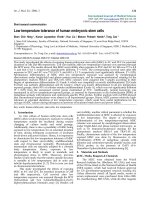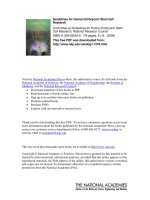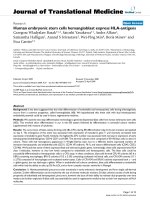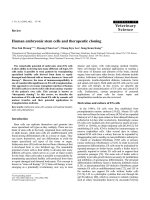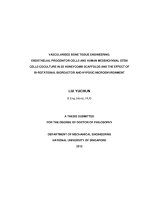Establishment of autologous culture systems for human embryonic stem cells
Bạn đang xem bản rút gọn của tài liệu. Xem và tải ngay bản đầy đủ của tài liệu tại đây (7.34 MB, 214 trang )
ESTABLISHMENT OF AUTOLOGOUS CULTURE
SYSTEMS FOR HUMAN EMBRYONIC STEM CELLS
FU XIN
(B.Sci (Hons.), NUS)
A THESIS SUBMITTED FOR THE DEGREE OF
DOCTOR OF PHILOSOPHY
DEPARTMENT OF ORAL AND MAXILLOFACIAL
SURGERY
FACULTY OF DENTISTRY
NATIONAL UNIVERSITY OF SINGAPORE
2010
Acknowledgements
Acknowledgements
With great pleasure in the completion of my project I would like to express my
deepest appreciation and gratitude to all those who provided their kind support
and motivation.
First and the foremost, I would like to express my sincere thanks to my
supervisor, Associate Professor Cao Tong, Vice Dean of Research, Faculty of
Dentistry, National University of Singapore, for giving me the opportunity to
join as a graduate student. I would like to thank my supervisor for his constant
encouragement, invaluable guidance and infinite patience throughout the
course of this study. He opened a new door in my life in the year 2006 and
molded me into a better human being filled with energy and exuberance to go
further in the road of academics.
I am deeply thankful to my Head of the Department, Associate Professor
Yeo Jin Fei, for his constant support towards the completion of my work on
time. Without the excellent facilities, this work would not have been
accomplished. The help and support provided by Associate Professor Grace
Ong Hui Lian, Dean, Faculty of Dentistry, in my studies, conference visits
and overseas studies is greatly appreciated.
I wish to express my warm and sincere thanks to Professor Yu Guang Yan,
Department of Oral and Maxillofacial Surgery, Peking University School of
Stomotology, for his advices and helps during my stay in Beijing, China when
I was conducting my joint project.
I also wish to thank my thesis committee members, Dr. Liu Hua and Dr.
i
Acknowledgements
ii
Toh Wei Seong for their invaluable helps, comments and guidance. Working
with them was a privilege. Their helps extending from the work to the minute
details during my thesis writing contributed a lot towards the timely
completion of my project.
The sincere help from all my group members, Mr. Lu Kai, Mr. Li Ming
Ming, Dr. Vinoth, Dr. Fahad and Dr. Sriram helped me a lot in working and
gaining knowledge. I wish to acknowledge their support and friendly working
environment. I am also thankful to Mr. Chan Sweeheng and Miss Lina for
their help.
The main backbone for my achievement is contributed to my beloved
family and precious friends. Their faith, encouragement and help pushed me to
become better by day in whatever I do. Without them, my life in Singapore
and the pursuit of my doctorate degree would not have been the same.
This work was supported by grants from the Ministry of Education of
Singapore (R223000014112 and R223000018112)
Table of Contents
Table of Contents
Acknowledgements i
Table of contents iii
Summary ix
List of Tables xii
List of Figures xiii
List of Abbreviations xvi
List of Publications xx
Chapter I: Literature Review 1
Literature Review 1
1.0. Introduction to Literature Review 2
1.1 Human embryonic stem cells (hESCs) 3
1.1.1. Derivation of hESCs 7
1.1.2. Characterization of hESCs 8
1.1.2.1. Cell surface and molecular markers 9
1.1.2.2. Pluripotency of hESCs 11
1.1.3. Signaling pathways involved in the self-renewal and
pluripotency of hESCs 12
1.1.3.1. FGF signaling pathway 12
1.1.3.2. Crosstalk between FGF-2 signaling and other signaling
pathways 14
1.1.4. Transcription factors controlling self-renewal and pluripotency
of hESCs. 15
1.2. Long-term maintenance of hESCs in culture 17
1.2.1. Maintenance of hESCs on MEF feeder 17
1.2.2. Maintenance of hESCs on human feeder layers 20
1.2.3. Maintenance of hESCs on autologous feeder layers derived
iii
Table of Contents
from hESCs 22
1.2.4. Maintenance of hESCs in feeder-free system 24
1.2.4.1. Components and functions of ECM derived from feeder
cells 24
1.2.4.2. ECM components from animal origin 25
1.2.4.3. Substrate derived from human origin 27
1.2.4.4. Growth of hESCs in suspension 30
1.3. Applications of hESCs 32
1.3.1. Regenerative medicine and cell therapy 32
1.3.2. Cytotoxicity testing, embryotoxicity screening and drug
discovery 35
1.3.3. Cellular model for basic science study 36
1.4. Towards clinical-grade hESCs 37
Chapter II: Hypotheses and Objectives 39
Chapter III: Materials and Methods 42
3.0 Introduction to materials and methods 43
3.1 Derivation of autologous feeder cells (H9-F) from H9 hESCs 43
3.1.1 Cultivation of H9 hESCs 44
3.1.1.1. Preparation of MEF 44
3.1.1.2 Expansion of H9 hESCs 46
3.1.2. Derivation of autologous fibroblast cells from H9 hESCs 47
3.1.2.1. Differentiation of H9 ebF from H9 hESCs 47
3.1.2.2 Derivation of H9 dF from H9 hESCs 48
3.2 Characterization and comparison of H9-F 48
3.2.1 Growth curve analysis 49
3.2.2. Identity analysis of H9-F by flow cytometry 49
3.2.3. Gene expression analysis by reverse transcription-polymerase
chain reaction (RT-PCR) 51
iv
Table of Contents
3.2.4. Evaluation of FGF-2 secretion in H9-F conditioned medium by
enzyme-linked immunosorbent assay (ELISA) 54
3.3. Characterization and comparison of H9 hESCs cultured on
autologous H9-F, MEF and feeder-free Matrigel
TM
55
3.3.1. Cultivation of H9 hESCs in various culture systems. 55
3.3.2 Cryopreservation assay 57
3.3.3. Immunofluorescence staining 58
3.3.4. Alkaline phosphatase (ALP) staining 60
3.3.5. Proliferation analysis 60
3.3.6. Pluripotency analysis by EB formation and teratoma formation
62
3.3.7. Undifferentiated states analysis of H9 hESCs cultured in
various systems. 64
3.3.7.1. Immunofluorescence staining and flow cytometry
analysis for Oct4 and SSEA-3/4 expression in hESCs 64
3.3.7.2. Conventional RT-PCR and real-time RT-PCR 65
3.3.8. Karyotype analysis 67
3.4. Cultivation of hESCs on H9 ebF-derived ECM in xeno-free,
serum-free and feeder-free conditions 68
3.4.1. Extraction of ECM from H9 ebF 68
3.4.2. Characterization of ECM by fluorescence confocal microscopy
69
3.4.3. Cultivation of H9 and H1 hESC lines on ECM in xeno-free,
serum-free and feeder-free conditions 70
3.4.3.1. Expansion of hESCs 70
3.4.3.2. Characterization of hESCs by immunofluorescence
staining and flow cytometry 71
3.4.3.2. Proliferation analysis 71
3.4.3.3. Pluripotency analysis by EB formation and teratoma
formation 72
v
Table of Contents
3.4.3.4. Undifferentiated state analysis by RT-PCR and real-time
RT-PCR 72
3.4.4. Application of ECM-supported hESCs 73
3.4.4.1. In vitro osteogenic differentiation of ECM-supported
hESCs 73
3.4.4.2. Cytotoxicity testing of NaF on ECM-supported H9
hESCs, H9 ebF and CRL1486 by MTS assay 74
3.5 Statistical Analysis 75
Chapter IV: Results 76
4.1. Derivation of autologous fibroblast cells from H9 hESCs 77
4.1.1. Morphology of H9 ebF 77
4.1.2. Morphology of H9 dF 77
4.2. Characterization and comparison of H9 ebF and H9 dF 80
4.2.1. Growth kinetics 80
4.2.2. Purity 81
4.2.3. Identity 83
4.2.4. Characterization 87
4.2.5. Synthesis and secretion of FGF-2 89
4.2.6. Karyotypes 91
4.2.7. Adherence of freeze-thawed H9-F for H9 hESCs culture 92
4.3. Characterization and comparison of H9 hESCs on H9-F, MEF and
feeder-free Matrigel
TM
93
4.3.1. Morphologies 93
4.3.2. Viability after cryopreservation 96
4.3.3. Expressions of undifferentiated markers 96
4.3.4. ALP activities 98
4.3.5. Comparisons of H9 hESCs on H9-F, MEF and feeder-free
Matrigel
TM
after long-term culture 99
4.3.5.1. Proliferation 99
vi
Table of Contents
4.3.5.2. Maintenance of undifferentiated states 103
4.3.5.3. Percentages of undifferentiated H9 hESCs 108
4.3.5.4. Maintenance of pluripotency 111
4.3.6. Karyotypes 116
4.4. Characterization of hESCs on H9 ebF-derived ECM in xeno-free,
serum-free and feeder-free conditions 117
4.4.1. Establishment of ECM stratum with H9 ebF 117
4.4.2. Characterization of H9 ebF-derived ECM 118
4.4.3. Morphologies of hESCs 120
4.4.4. Maintenance of undifferentiated states of hESCs 121
4.4.5. Percentage of undifferentiated hESCs 124
4.4.6. Proliferation of hESCs 126
4.4.7. Pluripotency of hESCs 127
4.5. Applications of ECM-supported hESCs 130
4.5.1. In vitro differentiation to osteogenic progenitors 130
4.5.2. Cytotoxicity testing of NaF on ECM-supported H9 hESCs by
MTS assay 131
Chapter V: Discussion 133
5.1 Feasibility of H9-F derivation 134
5.2. Similarities and differences in the properties of H9 ebF and H9 dF 135
5.3. Comparison of supportive effect on the growth of H9 hESCs by H9
ebF, H9 dF, MEF and feeder-free Matrigel
TM
138
5.3.1. The characteristics of H9 hESCs on H9-F 138
5.3.2. Better effect on the maintenance of undifferentiated states of
hESCs by H9 ebF in comparison with H9 dF 139
5.3.3. Better effect on the maintenance of pluripotency of hESCs by
H9 ebF in comparison with H9 dF 141
5.3.4. Higher proliferation activities and ectoderm differentiation
potentials of H9 hESCs in feeder-free Matrigel
TM
-mTeSR
TM
1 system
vii
Table of Contents
viii
143
5.4. Supportive effect of the xeno-free, feeder-free and serum-free system
for the growth of hESCs 145
5.4.1. Establishment of autologous feeder-derived ECM 145
5.4.2. Characterization of H9 ebF-derived ECM 146
5.4.3. Cultivation of H9 and H1 hESCs on ECM 148
5.4.4. Characterization of ECM-supported hESCs. 149
5.5. ECM-supported hESCs are applicable for regenerative medicine and
cytotoxicity testing 150
5.6. Animal Model 153
Chapter VI: Conclusion and Recommendation of Future Study 155
Chapter VII: Bibliography 159
Appendix 189
Summary
Summary
Background:Human embryonic stem cells (hESCs) hold great promise for
regenerative medicine due to their unlimited differentiation potential and
proliferation capacity. Currently, potential clinical applications of hESCs are
hampered by the use of mouse embryonic fibroblasts (MEF) and
animal-derived components during culture. Experimental modifications and
manipulations of hESCs require a feeder-free culture system to exclude the
confounding effects of feeder cells. Recent literature have demonstrated the
possibilities of culturing hESCs on autologous fibroblast, while others have
also demonstrated an alternative of culturing hESCs on a feeder-free system
with the aid of Matrigel
TM
. But none of them has systematically compared the
supportive abilities of these various systems for long-term undifferentiated
growth and pluripotency of hESC. In addition, animal origin of Matrigel
TM
necessitates the development of a feeder-free system with innovation of a
xeno-free matrix.
Hypotheses:The main hypothesis is that derivation of autologous feeder cells
from hESCs can be optimized and the ECM derived from the autologous
feeders can further support long-term undifferentiated growth of hESC in
xeno-free, serum-free and feeder-free condition.
ix
Summary
Methods: In this study, four sequential stages were conducted to prove our
hypothesis.
¾ Stage 1. Two sources of autologous fibroblasts were derived from H9
hESCs with initial embryoid body (EB) formation (H9 ebF) or with direct
differentiation (H9 dF).
¾ Stage 2. The properties of autologous fibroblasts were characterized
extensively by various assays.
¾ Stage 3. The supportive abilities of these two sources of autologous
fibroblasts were compared and characterized extensively, with MEF and
feeder-free Matrigel
TM
supported systems as the controls.
¾ Stage 4. The ECM substrate was extracted from the optimized autologous
fibroblast cells and utilized to support growth of H1 and H9 hESC lines in
the animal component free TeSR
TM
2 medium.
Results: We found that both H9 dF and H9 ebF could support undifferentiated
growth and morphology of hESCs for over 60 passages without chromosomal
aberrations. Quantitative analysis demonstrated that hESCs cultured on H9
ebF expressed higher level of hESCs-specific markers than H9 dF supported
hESCs. The degree of differentiation in routine hESCs culture is lower in H9
ebF culture system. The differentiation potential through acquisition of
three-germ layer markers is higher in EB samples from H9 ebF systems than
the ones from H9 dF system. In addition, the ECM derived from H9 ebF
x
Summary
xi
successfully supported normal growth of both H1 and H9 hESC lines for up to
20 passages in serum-free and xeno-free condition. The undifferentiated state
and pluripotency of hESCs cultured on autologous H9 ebF-derived ECM were
comparable to Matrigel
TM
.
Conclusions: In conclusion, autologous H9 ebF cells could serve as an
optimal feeder system to support undifferentiated cell growth of H9 hESCs.
We further developed a serum-free, xeno-free and feeder-free culture system
to support growth of both H1 and H9 hESC lines by use of ECM extracted
from H9 ebF. This study suggests a possible direction for the future
improvement in hESC culture system. This study also advances the
development of clinical-grade hESCs for both pre-clinical and clinical
applications in future.
List of Tables
List of Tables
Chapter I.
Table 1. Classification of stem cells regarding the developmental plasticity 3
Table 2. Characterization of stem cells by derivation source…………………6
Table 3. Overview of specific cell types differentiated from hESCs……….34
Chapter III
Table 4. Compositions of MEF derivation and freezing medium………… 45
Table 5. Components of PCR reaction mixtures…………………………….52
Table 6. List of Primers…………………………………………………… 53
Table 7. Cryopreservation of H9 hESCs from various culture systems…… 58
Table 8. Primers used in RT-PCR and real-time RT-PCR analysis for
hESCs ……………………………………………………………………….66
Table 9. Primers used in conventional and real-time RT-PCR for EB
samples……………………………………………………………………….67
Table 10. Composition of osteogenic differentiation medium……………….73
xii
List of Figures
List of Figures
Chapter I.
Figure 1. Schematic diagram of derivation of hESC lines from a human
blastocyst…………………………………………………………………….8
Chapter IV
Figure 2. Derivation of H9 ebF…………………………………………… 78
Figure 3. Derivation of H9 dF……………………………………………….79
Figure 4. Growth kinetics of H9 ebF and H9 dF from P2 to P20……………80
Figure 5. Flow cytometric analysis of H9-F surface expression of mouse MHC
I
d
marker…………………………………………………………………… 82
Figure 6. Flow cytometric analysis of H9-F surface expression of CD44
marker……………………………………………………………………… 84
Figure 7. Immunofluorescence staining of H9-F for expression of fibroblast
marker P4β………………………………………………………………… 85
Figure 8. Quantification of purity of fibroblastic H9-F by flow cytometric
analysis………………………………………………………………………86
Figure 9. Gene expression profiles of H9 ebF and H9 dF by conventional
RT-PCR………………………………………………………………………88
Figure 10. ELISA analysis of H9-F conditioned medium for concentration of
FGF-2……………………………………………………………………… 90
Figure 11. Karyotypes of autologous H9-F………………………………… 91
Figure 12. Morphologies of inactivated H9 ebF and H9 dF after thawing… 92
Figure 13. Morphologies of H9 hESCs on inactivated H9 ebF feeder cells…94
Figure 14. Morphologies of H9 hESCs on inactivated H9 dF feeder cells… 94
Figure 15. Morphologies of H9 hESCs on inactivated MEF feeder cells……95
xiii
List of Figures
Figure 16. Morphologies of H9 hESCs on feeder-free Matrigel
TM
………… 95
Figure 17. Immunofluorescence staining of hESC undifferentiated markers 97
Figure 18. Positive ALP staining of H9 hESCs cultured in various culture
systems……………………………………………………………………….98
Figure 19. Cell cycle analysis of H9 hESCs by PI staining……………… 100
Figure 20. Cell division tracking of H9 hESCs by CFDA-SE labeling 102
Figure 21. Comparison of gene expression profiles of H9 hESCs…………104
Figure 22. Real-time RT-PCR analysis of undifferentiated markers in H9
hESCs……………………………………………………………………….106
Figure 23. Quantification of spontaneous differentiation of H9 hESCs by
real-time RT-PCR ………………………………………………………….107
Figure 24. Flow cytometric analysis of hESCs-specific marker Oct4…… 109
Figure 25. Flow cytometric analysis of hESCs surface marker SSEA-4… 110
Figure 26. Teratoma formation in SCID mouse…………………………….111
Figure 27. H&E staining of teratoma sections…………………………… 112
Figure 28. Characterization of the pluripotency of H9 hESCs by in vitro EB
formation……………………………………………………………………114
Figure 29. Quantitative characterization of the pluripotency of H9 hESCs 115
Figure 30. Cytogenetic analysis of H9 hESCs by mFISH………………….116
Figure 31. Deposition of ECM from H9 ebF……………………………….117
Figure 32. Confocal images of the 3-D structure of fibroblast-derived
ECM……………………………………………………………………… 119
Figure 33. Morphologies of H1 and H9 hESCs cultured on fibroblast-derived
ECM, Matrigel
TM
and MEF respectively………………………………… 120
Figure 34. Immunofluorescence staining of hESCs for expression of
hESC-specific markers…………………………………………………… 121
xiv
List of Figures
xv
Figure 35. Gene expression patterns of hESCs by RT-PCR……………… 122
Figure 36. Quantitative analysis of gene expression patterns of hESCs by
real-time RT-PCR………………………………………………………… 123
Figure 37. Analysis of percentages of undifferentiated hESCs by flow
cytometry……………………………………………………………………125
Figure 38. Cell cycle analysis of hESCs (H1 and H9) on ECM and on
Matrigel
TM
………………………………………………………………… 126
Figure 39. Expression of three germ layer markers in EB specimens…… 127
Figure 40. Teratoma formations by ECM-supported H1 hESCs……………128
Figure 41. Teratoma formations by ECM-supported H9 hESCs… ……… 129
Figure 42. Alizarin Red staining of mineralized nodules differentiated from
ECM-supported H1 and H9 hESCs…………………………………………131
Figure 43. Cytotoxic effect of NaF on H9 hESCs, H9 ebF and CRLl486….132
List of Abbreviations
List of Abbreviations
Ad adipocyte
ALP Alkaline phosphatase
BMP bone morphogenetic protein
Bra brachyury
BSA bovine serum albumin
CCD cooled charged device
CFDA-SE 5-(and-6)-carboxyfluorescein diacetate,
succinimidyl ester
CGE colonic gut epithelium
CK-4 cytokeratin-4
Ct Cartilage
Ctrl control
D day
Dapi 4',6-diamidino-2-phenylindole
DC dendritic cells
DMEM dulbecco’s modified eagle’s medium
DMSO dimethyl sulfoxide
EB embryoid body
ECM extracellular matrix
ECVAM European center for the validation for the
alternative methods
xvi
List of Abbreviations
EDTA Ethylenediaminetetraacetic acid
ELISA enzyme-linked immunosorbent assay
Ep respiratory, brush-border, epithelium
FBS fetal bovine serum
FBXO F-box protein
FGF fibroblast growth factor
FGFR fibroblast growth factor receptor
FITC fluorescein isothiocyanate
GDF growth differentiation factors
GE grandular epithelium
HBSS hank’s balanced salt solution
hESC human embryonic stem cell
H9-F fibroblast cells derived from H9 hESCs
HLA human leukocyte antigen
HMM high molecular mass
H9 ebF fibroblast cell derived from outgrowth of EB
differentiated from H9 hESCs
H9 dF fibroblast cell differentiated directly from H9
hESCs without going through EB
ICM inner cell mass
IGFBP insulin-like growth factor binding protein
LD50 lethal doses, 50%
Lefty1 left right determination factor-1
xvii
List of Abbreviations
LIF Leukemia inhibitory factor
LMM low molecular mass
MCP monocyte chemoattractant protein
MEF mouse embryonic fibroblast
mFISH multi-color fluorescence in situ hybridization
MHC major histocompatibility complex
MHC I
d
MHC class I H-2K
d
MK Megakaryocyte
MMP14 matrix metalloproteinase-14
MSC mesenchymal stem cell
NaF sodium fluoride
Neg negative
NR neural rosettes
PBS phosphate buffered saline
PCP planar cell polarity
PEDF pigment epithelium derived factor
P4β proyly-4 hydroxylase β
PI propidium iodide
P1 Passage 1
PPAR-γ Peroxisome Proliferator-activated Receptor
gamma
ROCK Rho-associated Kinase
RT-PCR reverse transcription-polymerase chain reaction
xviii
List of Abbreviations
xix
SCID severe combined immunodeficiency
SDS sodium dodecyl sulfate
SM smooth muscle
SPP secreted phosphoprotein
SSEA Stage-specific embryonic antigen
STD Standard derivation
TE Trypsin/EDTA
TGF-β transforming growth factor-beta
3-D three-dimensional
Tra Tumor recognition antigen
UV ultraviolet
Vim vimentin
List of Publications
List of Publications
International Journal
1. Fu X, Toh WS, Liu H, Lu K, Li M, Hande MP, et al. (2009). Autologous
Feeder Cells from Embryoid Body Outgrowth Support the Long-Term
Growth of Human Embryonic Stem Cells More Effectively than Those
from Direct Differentiation. Tissue Eng Part C Methods.
International Conferences
1. Fu X, Liu H, Toh WS, Lu K, Li M, Hande MP, Yu GY, Deng X, Cao Y,
Xiao R, and Cao T. Establishment of Autologous Feeders for Human
Embryonic Stem Cells Propagation. 2nd Meeting of IADR Pan Asian
Pacific Federation (PAPF) and the 1st Meeting of IADR Asia/Pacific
Region (APR) (Sept. 22-24, 2009), Wuhan.
2. Fu X, Toh WS, Liu H, Lu K, Li M, Kidwai F, and Cao T. Application of
extracellular-matrix-supported human embryonic stem cells for
cytotoxicity testing. 24th IADR-SEA Division Annual Scientific Meeting
(September 19-21, 2010), Taipei
xx
Literature review
Chapter I
Literature Review
1
Literature review
1.0. Introduction to Literature Review
Human embryonic stem cells (hESCs) hold great promise for future clinical
applications because (1) they have unlimited self-renewal abilities and (2) they
retain pluripotency to differentiate into all cell types of human body. Therefore,
study of the cellular and molecular properties of hESCs provides information in
the culture, differentiation and applications of hESCs. A review of the current
signaling pathways helps us to understand the molecular mechanisms that
regulate the pluripotency and differentiation of hESCs. Conventionally, mouse
embryonic fibroblasts (MEF) are required to support long-term undifferentiated
growth of hESCs. Understanding of molecular mechanisms provided by MEF
helps us to improve existing culture system and develops a novel culture
methodology for hESCs. In 2007, Matrigel
TM
matrix, which is an extracellular
matrix (ECM) protein mixture secreted by mouse sarcoma cells, is developed to
support feeder-free propagation of hESCs. Insights into ECM properties and
functions facilitate future development of feeder-free and xeno-free culture
system for large-scale propagation of clinical-grade hESCs.
2
Literature review
1.1 Human embryonic stem cells (hESCs)
“Stem cell” is a distinct type of cell that can renew itself and give rise to
multiple specialized cell types [National institutes of health (NIH) stem cells
report, 2001]. Depending on the developmental plasticity of the cell, it is
classified into five categories, namely totipotent, pluripotent, multipotent,
oligopotent and unipotent stem cells (see Table 1).
Table 1. Classification of stem cells regarding the developmental plasticity
Categories Property Examples
Totipotent
Give rise to fully functional
organisms as well as every cell
type of the body (Sorgner, 2007).
Fertilized egg, blastomere
Pluripotent
Give rise to cells derived from all
three embryonic germ layers,
which are ectoderm, mesoderm
and endoderm. Can not form a
functional organism (Sorgner,
2007).
Embryonic stem cells
Multipotent
Give rise to limited types of cells
which are in the closely related
families (Sorgner, 2007).
Mesenchymal stem cells,
Hematopoietic stem cells
Oligopotent
Can differentiate into only a few
cells (Sorgner, 2007).
Lymphoid stem cells,
Myeloid stem cells
Unipotent
Retain self-renewal capacity but
can only produce one cell type
(Sorgner, 2007).
Muscle stem cells
Apart from the plasticity, stem cells can also be classified into six broad
groups according to their derivation sources, named embryonic stem cells
3
Literature review
(ESCs), embryonic germ cells, fetal stem cells, umbilical cord stem cells, adult
stem cells and induced pluripotent stem (iPS) cells (Ariff Bongso, 2005, see
Table 2). Each type of stem cells holds its own specific properties and
advantages. Among them, ESCs are more advantageous than other stem cells in
three ways: (1) ESCs have the ability to expand in vitro and maintain their
normal phenotypes through infinite population doublings without chromosomal
aberrations, providing a continuous and consistent source for research. (2) ESCs
can differentiate into virtually all the cell types of the body, providing a valuable
tool for differentiation and generation of broader range of cell types than other
stem cells. (3) ESCs are naturally-isolated from health embryo at blastocyst
stage and thus retain normal genotype without undesired genetic modifications.
The iPS cells are firstly generated in 2006 by ShinyaYamanaka’s group at
Kyoto University (Takahashi and Yamanaka, 2006) from mouse embryonic and
adult fibroblast by a forced expression of four reprogramming factors: Oct4,
Sox2, Klf4 and c-Myc using retrovirus system. In 2007, the same group
reported a milestone achievement by creating iPS cells from human fibroblast
using retroviral infection carrying the same four pivotal genes (Takahashi et al.,
2007). Another research group, led by James A. Thomson, independently used
lentiviral system to reprogrammed human somatic cells into pluripotent stem
cells (Yu et al., 2007) with partially overlapping combination: Oct4, Sox2,
Nanog and Lin28. The iPS cells are similar to naturally-isolated ESCs, in
respects to their self-renewing and pluripotent abilities, as well as the
4
